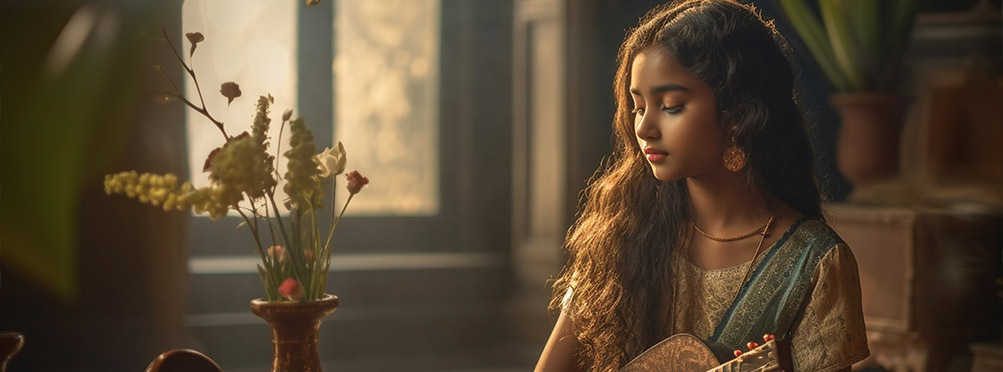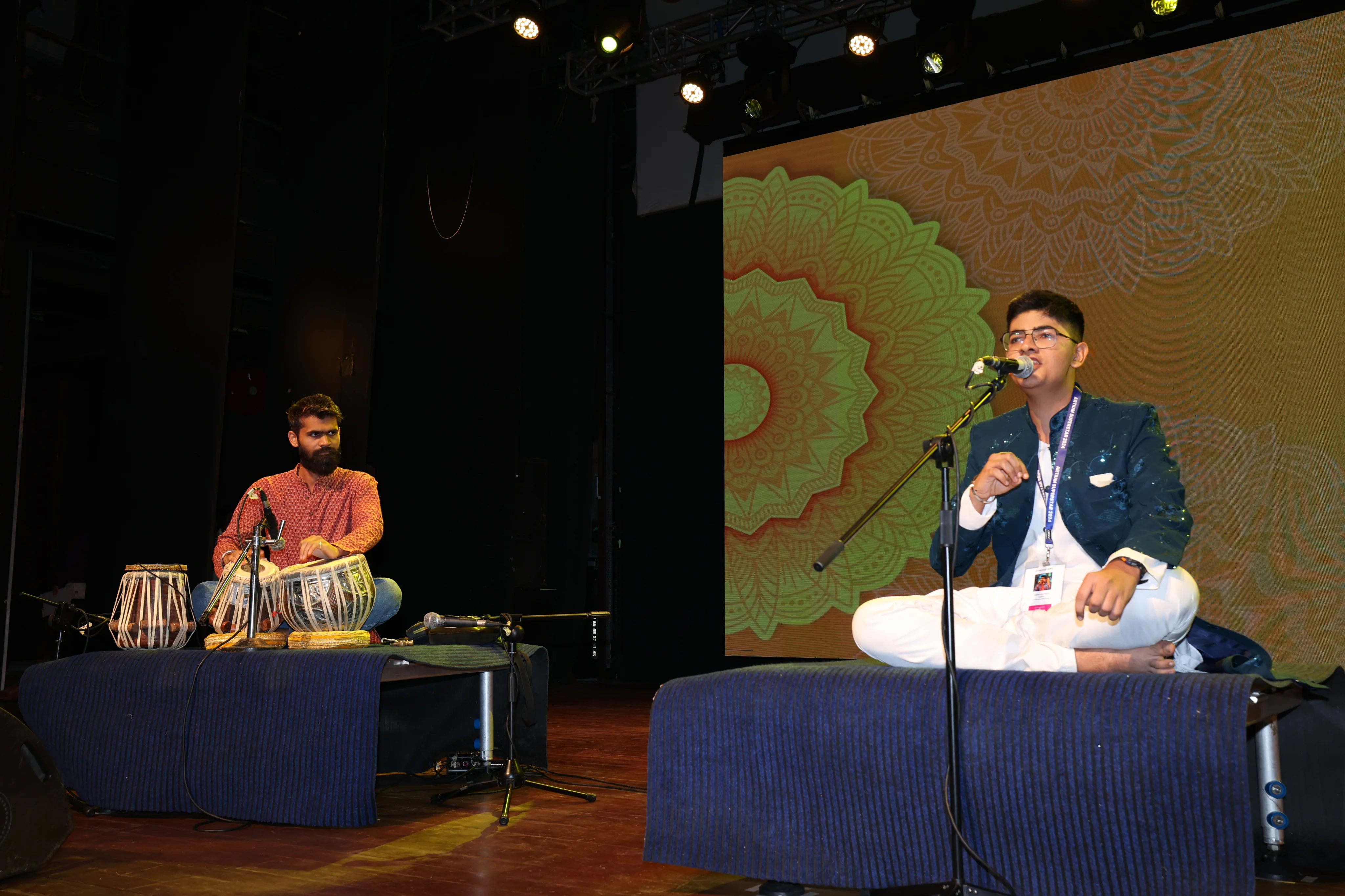All Topics
- Alchemizing Music Concepts for Students
- Artist Spotlight
- Artium Maestros
- Artium News
- Carnatic Music
- Devotional Music
- Editorials by Ananth Vaidyanathan
- Film Music
- Guitar
- Indian Classical Music
- Insights
- Instruments
- Karaoke Singing
- Kids Music
- maestros
- Music Education
- Music for Kids
- Music Industry
- Music Instruments
- Music Theory
- Music Therapy
- Piano
- Time Theory
- Tools
- Uncategorized
- Vocal Singing
- Vocals
What is a Raga in Music? A Beginner’s Guide to Understanding Ragas
What is a Raga in Music? A Beginner’s Guide to Understanding Ragas

Table of Contents
The lifeblood of all Indian classical music, whether Carnatic (South Indian) or Hindustani (North Indian), is the concept of Raag (in English, spelt and pronounced ‘raga’ after its Sanskrit form). Rags are intricate musical frameworks that have evolved over ages, each with their own distinct personality and mood. Understanding them is essential for comprehending and enjoying Indian classical music.
In this beginner’s guide, let’s explore what a raga is, how it can be performed and its importance. Whether you are a music enthusiast or a beginner, this guide will provide a comprehensive introduction to the world of ragas.
But before that…
If you’re really excited to start your journey in music, start with a free trial lesson today!
What is a Raga?
Ragas are derived from scales. The word Raag is derived from the Sanskrit word Rang which means ‘colour’ in many Indian languages. So we can say a raga is that which ‘colours the mind’ with a particular emotion. They are simply a collection of Sur and Swaras sung in a way that reflects a feeling.
Importance of Raga
Raags are an essential component of Indian classical music and a significant part of India’s rich cultural legacy. These melodic frameworks serve as a foundation for improvisation and exploration of many musical components such as rhythm, melody, and emotion.
One of the most essential characteristics of ragas is their capacity to elicit various moods and feelings in the listener. Each raga is connected with a certain time of day, season, or emotion, and a musician can create an ambiance that resonates with the listener’s feelings by playing a raag.
They also help in the development of a musician’s sense of discipline and structure in their practice. Raga’s are also a necessary instrument for conserving and transmitting cultural heritage. Musicians can assist to preserve these traditions alive and pass them on to future generations by learning and performing ragas.
Types of Ragas
There are over 83 different types of ragas in Hindustani classical music. Since it is not possible to cover all, let’s take a look at the main ones.
- Raag Asaravi- This is a parent raga, consisting of all the seven musical notes but arranged in a different pattern. This raga is usually supposed to be practiced in the late morning hours.
- Raag Bhairav- It is a raga that is equally and evenly paced through its singing patterns. Such ragas are suggested to be practiced in the early morning hours – usually, it’s the first raga you begin your practice with.
- Raag Bilawal- This is a parent raga that has its musical notes arranged randomly. This raga is typically supposed to be practiced in late-night hours and is the raag that is popular in the Indian genre of music – ghazals.
- Raag Kafi- It is the Hindustani equivalent of the Carnatic Raga Kharaharapriya. It is equally spaced in its singing patterns and is one of those ragas that form the foundation from which smaller ragas are made.
- Raag Kalyan- This raga is practically played in devotional music and spiritual songs. Its name is derived from the word “blessing”. It is one of the most played Ragas and is played generally in the evening hours.
- Raag Khamaj- This one is considered to be a more light-hearted Ragas and a very popular one in Indian classical music. It is usually played in the late hours of the night.
- Raag Marwa- It is also known as the sunset raga because it is usually sung in the evening. In this assortment of ragas, the fifth musical note or the pancham note is omitted.
Rules of to master Raga
There are a few rules to keep in mind when learning how to master Ragas. Let’s take a look at them in order to be able to smoothly sing them.
- Every Raga must have a Sa note in them.
- It should have Avaroha and Aaroha in it.
- The Raga always belongs to a “Thaat” and a Raga is given birth from a Thaat.
- Each Raga has a Madhyam or Panchan in them. Neither of these notes can be absent in a Raga.
- Two forms of the same note cannot follow each other in succession. But, there are exceptions to this rule. For example, Raag Jog takes Shuddha Gandhara and Komal Gandhar one after the other.
How to practice Raga?
Practicing Ragas can be a difficult undertaking, however, with proper dedication and practice one can easily excel in them. As a beginner, when you are starting to learn Ragas, here are some tips to keep in mind.
- Lower ranges first
Once you master your vocal chords, learning can be made very easy. It will be smoother to broaden your range because you shouldn’t risk injuring your throat. By practicing higher ranges, one can strain your throat and as a beginner it is not recommended.
- Practice different vocal ranges
When you initially begin learning to sing, it is important to determine your upper and lower ranges. After you’ve determined your high and low ranges, always warm up in them before attempting to hit ranges outside of your own range. Trying to perform songs by vocalists with similar voices to yours can also be really beneficial.
- Listening to Ragas
Pick a Raga and listen to it multiple times. Take your time and the idea is to let it soak in you so you can start sensing the flavour and nuances without much thought. Don’t worry too much about the details, keep listening to it with all your attention.
Conclusion
Raga is a fundamental form of music to learn and master. A raga has various healing benefits for the person singing it, as well as for the listener, that go beyond offering serenity and calm.
If you want to learn the different kinds of Ragas both in Carnatic music as well as Hindustani music join us at Artium Academy. Our professionals teach the basics as well as the advanced techniques so you can excel in your fields. With our goal based progress ladder, you can even track your growth. Join us today and begin your musical journey with our Indian classical music online classes. Learn music today with a free trial session.







[…] is Rhythm and Raga?‘Raga’ is a structure of specific Swara combinations, which creates a mood. In raga-based music, the […]